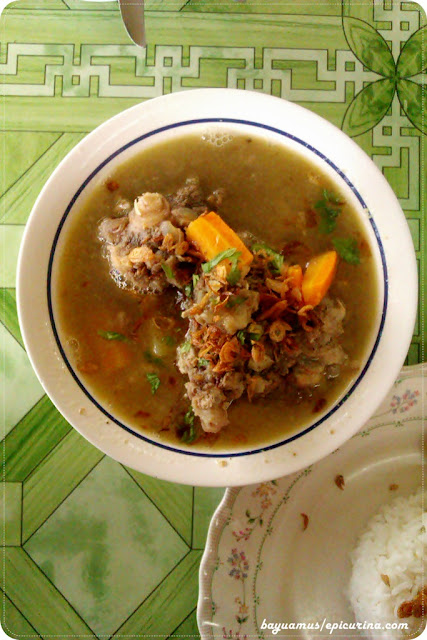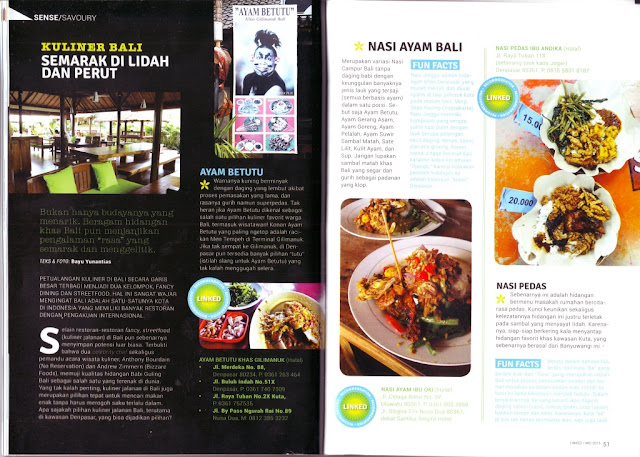While for the fancy restaurants kind Bali have Mozaic, Metis, and Sarong which frequently gained international acknowledgements; how about its street food? Are there any options worth to try?
Turned out it's the same thing; no less than two well known chefs with international TV shows praised the beauty of Babi Guling Ibu Oka in Ubud. They are: Anthony Bourdain (No Reservation) dan Andrew Zimmern (Bizzare Foods). Added Bobby Chinn to the list (World Café Asia), then there's been at least three international TV shows made its whole episode to elaborate on Bali's street food richness. In her travel show about Bali, Samantha Brown (Samantha Brown's Asia) also made sure that Babi Guling Ibu Oka is on her visit list.
Started her business since the 70s, currently Babi Guling Ibu Oka serves at least 500 customers everyday, and 1,000 on weekends; an achievement can hardly matched by most restaurants in Bali, even those backed by international reputation. The majority of Ibu Oka customers itself are tourists; either from Australia, Japan, as well as domestic ones.
In other places, Warung Nasi Ayam Kedewatan Ibu Mangku with its signature dish Nasi Ayam Bali, caters to at least 200 customers a day; and it's the same numbers of customers reported by Warung Mak Beng in Sanur selling Sup Kepala Ikan, or fish head soup. In all of those places, visitors willingly queue -- something rarely seen in Indonesia -- shared table (and sometimes sweats) with total strangers, for the sole interest of trying out the uniqueness and deliciousness of the signature dishes in those three warungs.
Local Taste
While the street food is often identical with discomfort, low hygiene, and there are many alternative options available in classier restaurants, what are the reasons tourists (especially foreigners) flocking those street food eateries?
While the writer can guess the reason himself, it gets verified in many inquiry emails received from fellow food lovers; both local or foreign ones planning to visit Bali. As they have quite limited knowledge about Bali good food scene, what they usually asked is which eateries are recommended to try out? And quite amazingly most of them don't really excited about fancy restaurants but instead for local dishes, which more than often can only be found on the street.
Upon asked why, turned out their reasons are usually revolves around the same reason about the importance of local taste: "We can find French fine dining easily where we live, so in Indonesia we want to try Indonesian real taste." Or to quote from another foodie: "Why would I want to travel across the globe from US to Bali only to eat Mexican food?"
One thing observed consistently from those emails are the high interest level of tourists wanting to get in touch with the 'local taste'; something that will be different from region to region, and would be hard to duplicate elsewhere. This is in line with the writer's own understanding that local food are best eaten not in fancy restaurants, but by the roadside instead.
While there are foreign tourists who disliked the discomforts of street food, the possibility of indigestion, or simply reluctant thus prefers to eat something they already familiar with back home; with the growing interest in ecotourism and backpack traveling, local experience is highly sought for by these new kind of tourists, and local food is part of that experience.
One of the advantage of street food compared with international restaurants, was highlighted in a conversation with a foodies couple from San Fransisco, USA. Among the Bali eateries the writer suggested, they seemed to be more amazed with Nasi Ayam Betutu Warung Liku, and Sop Buntut at Warung Nikmat Bakungsari, than with the array of western food restaurants stretched along Seminyak and Oberoi street. A thing that sometimes surprising -- good one though -- especially for those already familiar with those local food.
I think it attests to the importance of being able to wear other people's shoes, or take a step back from your own reality, and realize that something we considered so usual could be other people's source of amazement.
As with the opinion from the foodies couple, I considered them as valid since they travels to different countries a lot, and before reaching Bali they have eating their way through various SE Asian countries so there's no question about their reference pool. Not to mention that those two eateries mentioned are also well known among national foodies.
Based on this knowledge, the writer sure that if there are famous street food outside Bali that only has seen few foreign visitors, it must be because they're located in a less-popular tourist destinations, instead of having low quality or a serving a totally foreign taste preference.
Culinary Culture Ambassador
Among local tourists too, there are already many claims made as a testament of how eating experience is very important in traveling. It is done in following format:
“You haven't been to” + [region name] + “if you haven't eat at” + [street food name]
For example:
"You haven't been to Kuta if you haven't eat at Nasi Pedas Ibu Andika"
"You haven't been to Yogya if you haven't eat at Gudeg Yu Djum”
"You haven't been to Solo if you haven't eat at Nasi Liwet Wongso Lemu”
"You haven't been to Madiun if you haven't eat at Pecel Mbok Gembrot”
"You haven't been to Garut if you haven't eat at Nasi Liwet di Asep Stroberi”
Seeing the attraction tourists have towards the street food, the writer believe it's a sure indication that street food is one of the key players in introducing a particular region's identity, which in turn would help raising that region's attraction as a tourist destination.
Internationally speaking, street food could also plays a major role in help forming international perception about the quality and Unique Selling Point (USP) of a tourist destination; or even establish the perception of one nation's culinary quality.
Seeing that situation, it's not an overstatement if the writer think that street food is actually the ambassadors of a nation's culinary culture.
Therefore, Indonesia's participation in the World Street Food Congress in Singapura this June 2013 is something important, as it's a good chance to introduce Indonesian rich culinary culture to the international street food lovers; those who believes that the world's best food are usually found not in fancy restaurants, but by the roadside. (byms)





















2 comments:
Post a Comment